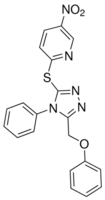All AbMole products are for research use only, cannot be used for human consumption.

For this product's availability, delivery time and price, please email [email protected] directly or click the "Inquiry Now" button below.
MIND4-17 is a potent NRF2 (nuclear factor erythroid 2-related factor 2) activator that covalently modifies a critical stress-sensor cysteine (C151) in the BTB domain of the E3 ligase substrate adaptor protein Kelch-like ECH-associated protein 1 (KEAP1), the primary negative regulator of NRF2. MIND4-17 induces NRF2 activation responses in neuronal and non-neuronal cultures (effective conc. 0.1-10 μM) of human, mouse, and rat origins. In addition, MIND4-17 effectively reduces endotoxin-induced IL-6 release from WT as well as YAC128 HD mutant mice-derived primary microglia and astrocytes, however, NRF2 induction by MIND4-17 is shown to be compromised in human Huntington′s diseased (HD) relative to non-disesed neural stem cells due to suppressive influence of the expanded CAG repeat mutation on pathway activation.
| Molecular Weight | 405.43 |
| Formula | C20H15N5O3S |
| CAS Number | 345989-24-4 |
| Solubility (25°C) | DMSO: 2 mg/mL (warmed) |
| Storage |
Powder -20°C 3 years ; 4°C 2 years In solvent -80°C 6 months ; -20°C 1 month |
| Related Products |
|---|
| DSPE-PEG-FA
DSPE-PEG2K-FA is a PEG derivative containing folic acid. DSPE-PEG2K-FA has a targeting effect and can bind to folic acid receptors in cancer cells. DSPE-PEG2K-FA forms micelles/lipid bilayers and can be used in research on targeted drug delivery systems. |
| Lifastuzumab
Lifastuzumab is a humanized anti-NaPi2b IgG1 monoclonal antibody. |
| GPVI antagonist 1
GPVI antagonist 1 is a glycoprotein VI (GPVI) platelet receptor antagonist. GPVI antagonist 1 inhibits collagen-induced platelet aggregation with an IC50 of 25.3 μM. |
| MPSD TFA
MPSD TFA (MARCKS-ED TFA) is a 25-amino acid peptide based on the effector domain sequence of the intracellular membrane protein myristoylated alanine-rich C-kinase substrate (MARCKS). MPSD TFA can sense membrane curvature and recognize phosphatidylserine. MPSD TFA can be utilized as biological probe to study membrane shape and lipid composition. |
| 4-Nitro-2,1,3-benzoselenadiazole
4-Nitro-2,1,3-benzoselenadiazole is a biochemical material that can be used in scientific research. |
All AbMole products are for research use only, cannot be used for human consumption or veterinary use. We do not provide products or services to individuals. Please comply with the intended use and do not use AbMole products for any other purpose.


Products are for research use only. Not for human use. We do not sell to patients.
© Copyright 2010-2024 AbMole BioScience. All Rights Reserved.
